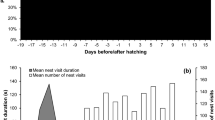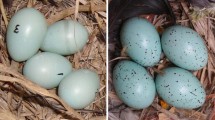Abstract
Like many other gobies, male Isaza (Gymnogobius isaza) which are endemic to Lake Biwa, Japan, exclusively care for broods in nests. This goby may have an optimal range of brood size (i.e., an average clutch size of about 2000–3000 eggs) within which they may produce larger numbers of hatching young because much larger broods may be destroyed by fungal infection before hatching. This optimal brood size hypothesis (Takahashi et al. in J Ethol 22:153–159, 2004) predicts that (1) after spawning, both males and females will refuse additional spawning by other gravid females (second females) to keep brood sizes within optimal ranges, (2) larger fish will repel second females more successfully than will smaller fish, and thus, (3) both sexes prefer larger mates. To examine these predictions, we first observed Isaza’s aggressive behaviors in aquaria and investigated whether fish attacked and repelled second females that were introduced after spawning, and, if so, what were the sizes of fish that did so. Large fish, regardless of sex, aggressively prevented second females from entering the nest, but second females larger than the pairs displaced the pair females forcibly and spawned eggs into their clutches. Mate choice experiments showed that males preferred large females. Although females’ choice of large mates was not confirmed, many results may largely coincide with the predictions of the optimal brood size hypothesis. Thus, Isaza males’ choice of large mates will be advantageous for defending against brood parasitism by conspecific females and for achieving optimal clutch size.


Similar content being viewed by others
References
Andersson M (1994) Sexual selection. Princeton University Press, Princeton
Arnqvist G, Rowe L (2005) Sexual conflict. Princeton University Press, Princeton
Barlow GW (1984) Patterns of monogamy among teleost fishes. Arch Fisch Wiss 35:75–123
Barlow GW (1991) Mating systems among cichlid fishes. In: Keenleyside MHA (ed) Cichlid fishes: behaviour, ecology and evolution. Chapman and Hall, London, pp 173–190
Belles-Isles JC, FitzGerald GJ (1991) Filial cannibalism in sticklebacks: a reproductive management strategy? Ethol Ecol Evol 3:49–62
Forsgren E, Karlsson A, Kvarnemo C (1996) Female sand gobies gain direct benefits by choosing males with eggs in their nests. Behav Ecol Sociobiol 39:91–96
Gomagano D, Kohda M (2007) Partial filial cannibalism enhances initial body conditions and size of a paternal nest brooding fish that faces with strong male–male competition. Ann Zool Fenn 45:55–65
Hidaka T, Takahashi S (1987) Reproductive strategy and interspecific competition in the lake-living gobiid fish Isaza, Chaenogobius isaza. J Ethol 5:185–196
Ichikawa N (1990) Egg mass destroying behaviour of the female giant water bug, Lethocerus deyrollei Vuillefroy (Heteroptera: Belostomatidae). J Ethol 8:5–11
Ichikawa N (1991) Egg mass destroying and guarding behaviour of the giant water bug, Lethocerus deyrollei Vuillefroy (Heteroptera: Belostomatidae). J Ethol 9:25–29
Ichikawa N (1993) Biased operational sex ratio causes the female giant water bug Lethocerus deyrollei to destroy egg masses. J Ethol 11:151–152
Ichikawa N (1994) Counterstrategy against infanticide of the female giant water bug Lethocerus deyrollei (Hemiptera: Belostomatidae). J Insect Behav 8:181–188
Ito S, Yanagisawa Y (2000) Mate choice and cannibalism in a natural population of a stream goby, Rhinogobius sp. Ichthyol Res 47:51–58
Ito S, Yanagisawa Y (2003) Mate choice and mating pattern in a stream goby of the genus Rhinogobius. Env Biol Fish 66:67–73
Knotek WL, Orth DL (1998) Survival for specific life intervals of small-mouth bass, Micropterus dolomieu, during parental care. Environ Biol Fish 51:285–296
Kobayashi S, Yamanaka Y (1950) Studies on propagation of Chaenogobius isaza Tanaka. I: on the spawning habit and growth. J Shiga Pref Exp Stat Fish 1:2–9 (in Japanese)
Kobayashi S, Yamanaka Y (1952a) Studies on propagation of Chaenogobius isaza Tanaka. II: preliminary consideration on the resources of isaza. J Shiga Pref Exp Stat Fish 1:2–6 (in Japanese)
Kobayashi S, Yamanaka Y (1952b) Studies of propagation of Chaenogobius isaza Tanaka. III: life history of Isaza. Rep Shiga Pref Fish Res Lab 3:1–5 (in Japanese)
Kobayashi S, Yamanaka Y, Torii R (1950) Spawning habit of Chaenogobius isaza Tanaka: preliminary report. Bull Jpn Soc Sci Fish 15:808–812 (in Japanese)
Kuwamura T (1984) Social structure of the protogynous fish Labroids dimidiatus. Publ Seto Mar Biol Lab 29:117–177
Kuwamura T (1997) The evolution of parental care and mating systems among Tanganyikan cichlids. In: Kawanabe H, Hori M, Nagoshi M (eds) Fish communities in Lake Tanganyika. Kyoto University Press, Kyoto, pp 59–86
Kuwamura T, Nakashima Y, Yogo Y (1994) Sex change in either direction by growth-rate advantage in the monogamous coral goby, Paragobiodon echinocephalus. Behav Ecol 5:434–438
Lindström K, Hellstrom M (1993) Male size and parental care in the sand goby, Pomatoschistus minutus. Ethol Ecol Evol 5:97–106
Manica A (2002) Filial cannibalism in teleost fish. Biol Rev 77:261–277
Nagoshi M (1966) Ecological studies on the population of Isaza, Chaenogobius isaza, in Lake Biwa, with special reference to the effects of population density upon its growth. Res Popul Ecol 8:20–36
Rohwer S (1978) Parent cannibalism of offspring and egg raiding as a courtship strategy. Am Natur 112:429–440
Sargent RC, Gross MR (1993) William’s principle: an explanation of parental care in teleost fishes. In: Pitcher TJ (ed) Behaviour of teleost fishes. Chapman and Hall, London, pp 335–361
Semel B, Sherman PW (2001) Intraspecific parasitism and nest-site competition in wood ducks. Anim Behav 61:787–803
Sherman PW (2001) Wood ducks: a model system for investigating conspecific parasitism in cavity-nesting birds. In: Dugatkin LA (ed) Model systems in behavioral ecology: integrating conceptual, theoretical and empirical approaches. Princeton University Press, Princeton, pp 311–337
Shibata J, Kohda M (2006) Seasonal sex role changes in the blenniid Petroscirtes breviceps, a nest brooder with paternal care. J Fish Biol 69:203–214
Takahashi S (1974) Sexual maturity of Isaza (Chaenogobius isaza) -1. The seasonal changes of growth and sexual maturation. Bull Japan Soc Sci Fish 40:847–857
Takahashi D, Kohda M (2004) Courtship in fast water currents by a male stream goby (Rhinogobius brunneus) communicates the parental quality honestly. Behav Ecol Sociobiol 55:431–438
Takahashi D, Yanagisawa Y (1999) Breeding ecology of amphidromous goby of the genus Rhinogobius. Ichthyol Res 46:185–191
Takahashi D, Kohda M, Yanagisawa Y (2001) Male–male competition for large nests as determinant of male mating success in a Japanese stream goby, Rhinogobius sp. DA. Ichthyol Res 48:91–95
Takahashi D, Asada H, Takeyama T, Takahata M, Katoh R, Awata S, Kohda M (2004) Why egg-caring males of Isaza (Gymnogobius isaza Gobiidae) refuse additional females: preliminary field observations. J Ethol 22:153–159
Takegaki T, Nakazono A (1999) Reproductive behaviour and mate fidelity in the monogamous goby, Valenciennea longipinnis. Ichthyol Res 46:115–123
Wittenberger JF, Tilson RL (1980) The evolution of monogamy: hypotheses and evidences. Annu Rev Ecol Syst 11:197–232
Acknowledgments
We are grateful to Dr S. Takahashi (Ryukoku University), Dr K Yamaguchi (Shinjiko Nature Museum), and Dr D. Takahashi (Nagano University) for providing valuable information, and to Dr K. Goto (Kyoto University) for his useful comments on our manuscript. Thanks are also due to the members of the Laboratory of Animal Sociology, Osaka City University, for their discussion and support with fish capture. We also thank the Momose Fishermen’s Cooperative Association for capturing Isaza. We thank three anonymous reviewers who gave helpful comments. Financial support (to MK) by the Grant-in-Aids for Scientific Research from the Japanese Ministry of Education, Science, Sports, Culture and Technology is gratefully acknowledged.
Author information
Authors and Affiliations
Corresponding author
About this article
Cite this article
Morimoto, Y., Shibata, Jy., Takahata, M. et al. Male Isaza (Gymnogobius isaza, Gobiidae) prefer large mates: a counterstrategy against brood parasitism by conspecific females. J Ethol 28, 429–436 (2010). https://doi.org/10.1007/s10164-009-0201-9
Received:
Accepted:
Published:
Issue Date:
DOI: https://doi.org/10.1007/s10164-009-0201-9




